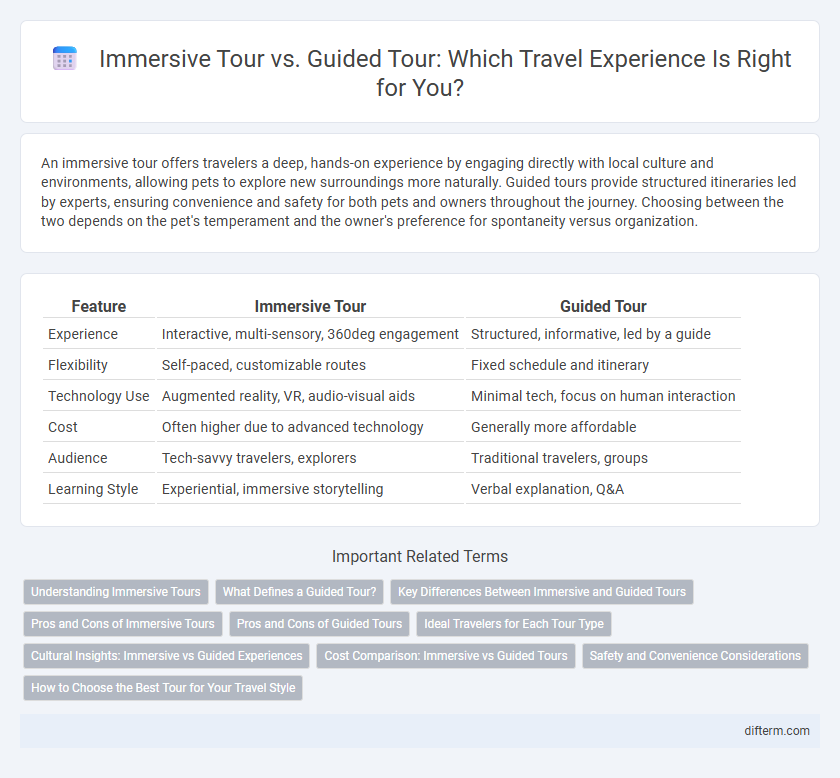An immersive tour offers travelers a deep, hands-on experience by engaging directly with local culture and environments, allowing pets to explore new surroundings more naturally. Guided tours provide structured itineraries led by experts, ensuring convenience and safety for both pets and owners throughout the journey. Choosing between the two depends on the pet's temperament and the owner's preference for spontaneity versus organization.
Table of Comparison
| Feature | Immersive Tour | Guided Tour |
|---|---|---|
| Experience | Interactive, multi-sensory, 360deg engagement | Structured, informative, led by a guide |
| Flexibility | Self-paced, customizable routes | Fixed schedule and itinerary |
| Technology Use | Augmented reality, VR, audio-visual aids | Minimal tech, focus on human interaction |
| Cost | Often higher due to advanced technology | Generally more affordable |
| Audience | Tech-savvy travelers, explorers | Traditional travelers, groups |
| Learning Style | Experiential, immersive storytelling | Verbal explanation, Q&A |
Understanding Immersive Tours
Immersive tours leverage advanced technology such as virtual reality and augmented reality to create fully engaging experiences that simulate real-life locations and interactions, offering travelers deeper cultural and historical understanding. Unlike traditional guided tours led by a person, immersive tours allow exploration at one's own pace and provide interactive elements that enhance learning and retention. This innovative approach to travel experience delivers a more personalized and memorable journey by combining sensory engagement with educational content.
What Defines a Guided Tour?
A guided tour is defined by the presence of an expert tour guide who provides detailed commentary, historical context, and answers questions throughout the journey, ensuring a structured and informative experience. This format often follows a planned itinerary, highlighting key landmarks and cultural insights with a focus on education and engagement. Tourists benefit from personalized narratives and local expertise that enhance understanding of the destination's significance.
Key Differences Between Immersive and Guided Tours
Immersive tours engage travelers through interactive experiences and sensory involvement, allowing them to explore destinations with a sense of personal discovery, while guided tours offer structured itineraries led by an expert providing historical, cultural, and practical insights. Immersive tours prioritize participant engagement and often incorporate technology such as virtual reality or augmented reality, enhancing the depth of exploration beyond traditional narration. Guided tours emphasize comprehensive knowledge delivery and convenience, making them ideal for travelers seeking detailed commentary and organized logistics during their journey.
Pros and Cons of Immersive Tours
Immersive tours offer a deeply engaging experience by using technologies like virtual reality or augmented reality, allowing travelers to explore destinations in a highly interactive and personalized manner. They provide flexibility and accessibility, enabling users to visit multiple sites without the constraints of a physical guide, but can lack the rich storytelling and local insights provided by a human expert. However, immersive tours may require technical skills or equipment, and the absence of spontaneous human interaction can reduce the authenticity and emotional connection often found in guided tours.
Pros and Cons of Guided Tours
Guided tours offer structured itineraries led by knowledgeable guides who provide historical context and local insights, enhancing the overall travel experience. However, they often limit flexibility and spontaneity, adhering to fixed schedules and group preferences that may not align with every traveler's interests. Despite these constraints, guided tours ensure efficient navigation through popular sites and typically guarantee access to exclusive locations or priority entry, which self-guided or immersive tours may lack.
Ideal Travelers for Each Tour Type
Immersive tours attract solo adventurers and culture enthusiasts who seek deep, authentic experiences through hands-on activities and local interactions. Guided tours suit first-time travelers and groups preferring structured itineraries, knowledgeable guides, and ease of navigation through popular landmarks. Understanding these preferences helps travelers select the ideal tour type for a fulfilling and personalized travel experience.
Cultural Insights: Immersive vs Guided Experiences
Immersive tours offer deep cultural insights by engaging travelers directly with local customs, traditions, and everyday life, creating authentic, firsthand experiences. Guided tours provide structured cultural knowledge through expert narration and curated visits to key historical sites and landmarks. Immersive experiences foster personal connections and nuanced understanding, while guided tours ensure comprehensive coverage of significant cultural highlights.
Cost Comparison: Immersive vs Guided Tours
Immersive tours often come at a higher upfront cost due to advanced technology and personalized experiences but can offer greater value through deeper engagement and exclusive access. Guided tours typically have lower prices with structured itineraries, making them budget-friendly but potentially less flexible and interactive. Evaluating cost against the desired level of immersion and personalization helps travelers choose the best option for their budget and travel goals.
Safety and Convenience Considerations
Immersive tours prioritize safety by limiting group sizes and using advanced virtual reality technology to minimize physical risks, making them ideal for travelers with health concerns or mobility issues. Guided tours offer convenience through expert-led navigation and real-time assistance, ensuring a secure experience in unfamiliar locations. Both options enhance safety protocols, but immersive tours reduce exposure to crowded environments, while guided tours provide immediate support and local knowledge.
How to Choose the Best Tour for Your Travel Style
Choosing the best tour for your travel style depends on your preference for engagement and flexibility; immersive tours offer hands-on cultural experiences and personal interactions, while guided tours provide structured itineraries with expert commentary. Consider your desired level of independence and the depth of local knowledge you seek to maximize enjoyment and learning. Evaluating factors such as group size, schedule rigidity, and interest in authentic experiences helps determine whether an immersive or guided tour aligns better with your travel goals.
Immersive Tour vs Guided Tour Infographic

 difterm.com
difterm.com